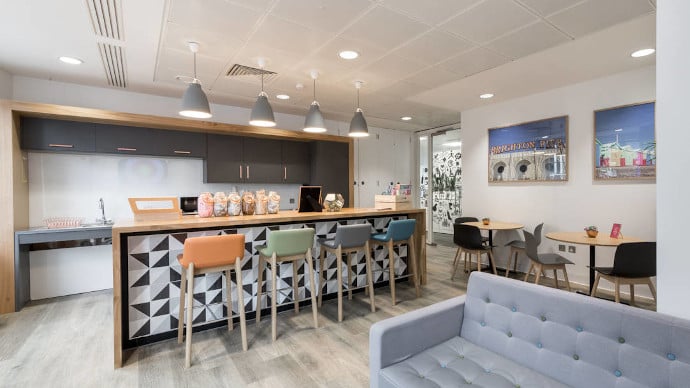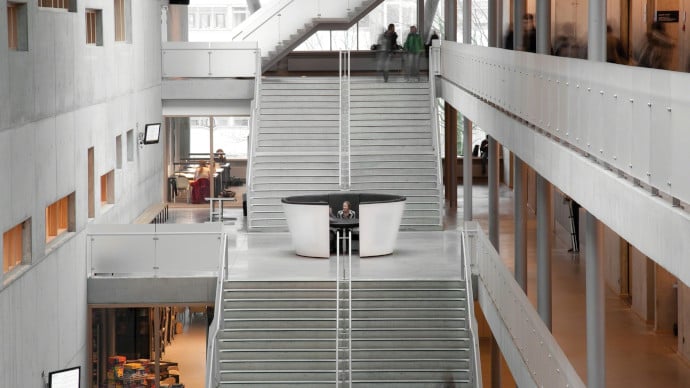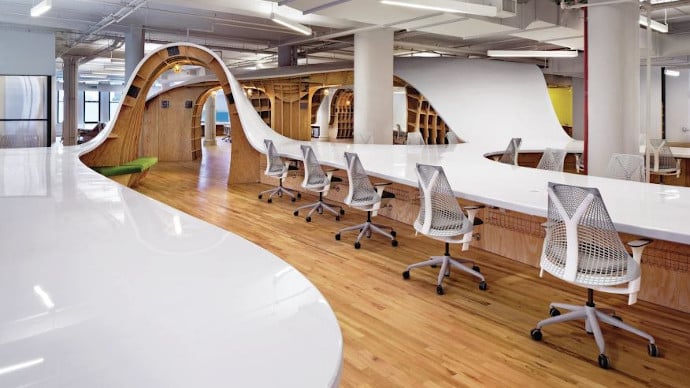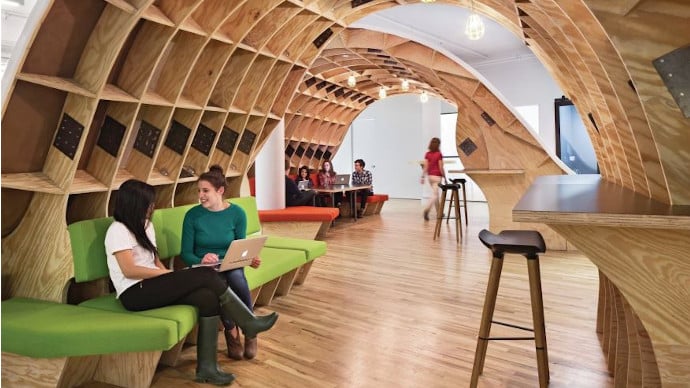Serendipity is what drives businesses forward. The accidental collisions that force interaction and strengthen relationships between co-workers. The casual chats or impromptu meetings over coffee that spark innovative ideas.
But how much serendipity in the workplace is owed to chance?
And how can organisations continue to benefit from those serendipitous moments in the new era of hybrid work?
Serendipity: the key to innovation
“Serendipity means finding interesting or valuable things by chance. It’s what happens when we make unexpected connections and create possibilities that never existed before.”
Innovative products and services are not created behind desks or in a boardroom full of executives. They happen when the right people cross paths with each other and bounce ideas around.
Steve Jobs understood that serendipity was the key to innovation. It’s why he never separated the engineers and the designers into separate divisions. He wanted them constantly rubbing shoulders and bouncing ideas off each other.
In fact, many leaders in innovation have expressed the value of interaction and chance encounters. Google claim chance encounters amongst employees were responsible for innovations such as Gmail and Street View.
Serendipitous connections and chance encounters in the workplace can create opportunities for collaboration between unlikely partners, which can spark ideas, lead to new solutions, or at the very least, strengthen relationships and foster a happier and more productive workforce.
In fact, it was these impromptu interactions with colleagues that people missed most about the office whilst working from home during the pandemic.
Engineered serendipity: organisations aren’t leaving it down to chance
Serendipitous moments in the workplace may be down to chance, but the environment in which they occur is not. The workplace itself can provide the routes and the prompts to encourage serendipity.
As Rachel Emma Silverman, writing for The Wall Street Journal, explains;
“Attempts to engineer serendipity aren't entirely new. Steve Jobs famously designed the Pixar headquarters with central bathrooms so that people from around the company would run into each other. And firms have increasingly adopted open plans and even unassigned seating to get workers mingling more widely.”
When organisations started to tear down the cubicle walls and open up the office floor, the hope was that it would bring people together and increase the opportunities for unexpected connections.
Some companies are taking a more scientific approach. They are collecting and analysing data about their teams to predict the likelihood that employees will meet. Others are trying playful tactics like trivia games and similar icebreakers to get employees talking in dead spaces where they might bump into each other, such as in corridors or lifts.
The space around us affects how we behave and our ability to connect with others. And companies of all sizes and sectors are realising the power of workplaces designed for connection and serendipity.
Employers keen to maximise these connections have long been using this to steer their workplace design.
Office design for serendipity
One of the focal points of a workplace designed for serendipity is the WorkCafé or breakout area.
Removing coffee points in each department in favour of a centralised cafe or breakout area brings everyone together and dilutes the boundaries between the different disciplines of the business. As people from different parts of the company visit the space to refuel and refresh, it becomes a hub for unexpected conversations to take place.

Bar-style seats support on-the-fly conversations as people drink their coffee and prepare their lunch. While other furniture such as tables and comfortable seating support deeper conversations. For example, Border by Orangebox, is a linear bench and worktable that can be used in both café areas and a variety of open-plan spaces.
.jpg?width=800&name=My%20project%20(75).jpg)
As well as shared spaces, there is a trend towards open staircases that increase visibility from floor to floor and encourage spontaneous conversations amongst workers in a way that can’t be mimicked when using a lift.

Weaving comfortable seating into the flights of stairs encourages people to continue serendipitous moments for longer. When two colleagues bump into each other at the top of stairs, both on their way down, it’s natural that the conversation will end when they find their way to the bottom. Placing seating and even desks along their route can prompt them to stop so they can continue discussions.
At the International Olympic Committee, a central staircase shaped like the five rings of the Olympic symbol encourages people from different departments to encounter one another on the way to and from their desks. The spaces around the staircase are full of sofas and coffee corners.
.jpg?width=800&name=My%20project-1%20(10).jpg)
Elsewhere in the office, informal seating like sofas intermixed with desks and high tables support sociability and connection.The presence of a sofa or armchairs, like the Savina from Viccarbe, makes a space more inviting for people to stop by and start a spontaneous conversation as they’re passing through. Likewise, stackable stools like the Bimbo by Blastation can be easily pulled out in areas short on space.
.jpg?width=800&name=My%20project-1%20(8).jpg)
.jpg?width=800&name=My%20project-1%20(9).jpg)
The Montara650 collection from Coalesse also offers a range of tables and chairs in multiple heights and shapes, to suit any space. An optional grommet hosts the PowerPod to charge devices, enabling workers to pull up something on screen to aid their discussion without worrying about battery.
.jpg?width=800&name=My%20project-1%20(7).jpg)
Clive Wilkinson’s Superdesk is perhaps one of the most creative office installations for encouraging connection and chance encounters.
In 2014, he created a 410m2 continuous desk for digital advertising agency The Barbarian Group in Manhattan. The desk undulates and then levels out, with the spaces under the desk creating space for private work or collaboration.
Benjamin Palmer, co-founder of The Barbarian Group, told The Architectural Review;
“I know we’ve had ideas we wouldn’t have had if people weren’t sat around each other in this way.”


Image source: Architect magazine
Facilitating serendipity in the hybrid office
Could the rise of hybrid working reduce these serendipitous moments? People are coming into the office two-to-three days rather than five, and when there, are surrounded by a smaller pool of colleagues to ‘bump into’.
Yet, workers have never been more aware of the value of face-to-face interaction, and may now be more motivated to stop for those impromptu conversations than they would have in the past. Before, they may have just walked on by.
What’s more, some organisations offering hybrid work are introducing hot desking systems, so when people are in the office, they’re not always sitting with the same people. This opens up more opportunities for people to interact with those outside of their immediate teams.
And what about remote connections? Can serendipity happen virtually?
The likes of Netflix and The New York Times have turned to Watercooler, an extension of Slack, which organises introductions among teammates and offers conversation topics to stimulate non-work related communication. It’s organised, or steered, serendipity. Much like office design plays a role in facilitating those connections in the flesh.
As hybrid work becomes the ‘new normal’, we can be sure to expect more innovations that get people together in a structured but organic way to facilitate collaboration and relationship building. But when it comes to being in the office, the same design rules for serendipity that organisations have been levering for years, still work.
Summary
As Libby Sander summarises in an article for Work Design Magazine;
“Serendipity or chance encounters that lead to something are more likely in environments where things are not completely planned, where informal conversations are encouraged, and where the workspace design enables chance encounters.”
Leaving serendipity to chance is a risky strategy. But the workplace can be designed and furnished in such a way that it provides the routes and prompts for chance encounters to happen. Hybrid working may even make workers more likely to take advantage of these opportunities.










